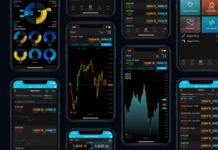
Making a living through trading sounds enticing, but many underestimate the commitment and strategy involved. It’s not about luck or gut feelings; it’s about structured approaches, continuous learning, and adapting to economic signals. Let’s explore what it really takes to make this a sustainable career choice.
Key Points
- Consistent profitability requires a strategy rooted in sound economic principles.
- Automated tools streamline execution but need careful monitoring.
- Risk management and discipline are non-negotiable.
- Economic indicators guide long-term decisions.
- Diversification reduces volatility and enhances stability.
The Role of Technology in Full-Time Trading

Modern tools are indispensable for success. Platforms providing market depth, volume analysis, and automated execution save time and improve efficiency.
An automated trading platform like MultiCharts offers features such as depth of market (DOM) analysis, enabling traders to see ten price levels, volume profiles, and entry/exit automation directly in the DOM window.
But tools alone won’t make you profitable. They work best when paired with a sound strategy and thorough understanding of market movements. Technology amplifies your edge; it doesn’t create it.
Building a Strategy Rooted in Economic Principles
Markets are a reflection of economic realities. Interest rates, inflation trends, and GDP growth influence everything. Start by identifying sectors that align with these trends.
For example, dividend-paying stocks in stable sectors perform well during low-interest periods.
Essential Steps for Strategy Development:
- Analyze macroeconomic indicators: Identify trends that may influence asset classes.
- Perform fundamental analysis: Assess company financials to predict long-term sustainability.
- Test strategies: Use backtesting tools to ensure robustness across market cycles.
Sound strategies focus on long-term consistency, avoiding the allure of quick gains. Balance risk with reward to avoid common pitfalls.
Risk Management: The Foundation of Sustainability
Success hinges on limiting losses. Effective risk management includes setting position sizes, stop-loss levels, and exit points.
Risk Management Rules:
- Never risk more than 2% of capital on a single trade.
- Allocate assets across multiple instruments to reduce exposure.
- Monitor leverage carefully to avoid overextension.
A balanced portfolio smoothens volatility, ensuring losses don’t wipe out gains. Consistency beats aggressiveness in the long run.
Diversification and Its Role in Reducing Volatility

Concentrated positions can lead to disaster. Diversification spreads risk across asset classes, industries, and even countries.
Imagine investing solely in tech during a downturn. Broadening your portfolio to include consumer staples or bonds cushions potential losses. This approach ensures you weather all types of markets.
Economic Indicators to Watch
Monitoring economic data gives you a competitive advantage. Indicators signal shifts in market conditions, guiding informed decisions.
Key Indicators:
- Interest rates: Affect borrowing costs and corporate profitability.
- Inflation: Impacts purchasing power and commodity prices.
- GDP growth: Reflects economic health and consumer activity.
Paying attention to these signals provides clarity, allowing better timing and allocation of resources.
The Psychology of Full-Time Trading
Mental toughness separates amateurs from professionals. Emotion-driven decisions lead to unnecessary losses.
How to Maintain Discipline:
- Follow pre-defined rules for entries and exits.
- Avoid overtrading by sticking to your strategy.
- Accept losses as part of the process without overreacting.
- Mindset determines longevity. Patience and discipline build success.
Practical Applications for Long-Term Investors

Equity-focused investors benefit from strategies rooted in economic theory. Dividend-paying stocks offer income while retaining growth potential. Identify companies with consistent earnings, strong cash flow, and manageable debt.
A histogram below illustrates the dividend yield distribution across different sectors, helping you identify reliable options.
The graph shows the average dividend yield percentages for Utilities, Consumer Staples, Technology, Real Estate, and Healthcare sectors. Here’s what the data reveals:
- Utilities (3.8%): Known for stability, this sector provides consistent yields, making it a favorite during uncertain economic periods.
- Consumer Staples (3.1%): Companies in this sector typically perform well regardless of market conditions, offering moderate but reliable yields.
- Technology (1.2%): Lower yields here reflect a focus on reinvestment for growth, rather than paying high dividends.
- Real Estate (4.4%): Often the highest-yielding sector, driven by real estate investment trusts (REITs) that distribute significant income to shareholders.
- Healthcare (2.9%): A balanced option with moderate yields, benefiting from long-term demand and innovation.
This comparison highlights the importance of sector selection in dividend-focused strategies. Combining high-yield sectors with those offering growth potential ensures a well-rounded portfolio. Use this data to evaluate where your investments can generate consistent returns while managing risk effectively.
The Value of Continuous Education
Markets evolve constantly. Staying informed keeps you ahead.
Read economic reports, attend webinars, and collaborate with experienced professionals. Networking with like-minded individuals sharpens your analytical skills. The more you learn, the better equipped you’ll be to adapt.
Mastering Market Timing Without Chasing Trends
Timing matters, but reacting impulsively to market trends leads to errors. Effective timing stems from analyzing patterns and aligning them with macroeconomic conditions. Successful investors wait for confirmation before entering positions rather than jumping on every opportunity.
For instance, during a high-interest-rate environment, cyclical stocks often struggle, whereas defensive sectors like utilities thrive. Understanding this relationship allows you to adjust your approach and enter trades when conditions align with your analysis. Being selective ensures fewer mistakes and better outcomes.
The Importance of Liquidity in Financial Markets
Liquidity defines how easily assets can be bought or sold without affecting their price. It’s a critical factor that often gets overlooked. High liquidity means tighter spreads and easier trade execution, essential for minimizing transaction costs.
Assets with low liquidity, such as certain small-cap stocks, carry higher risk as prices can swing wildly. Always assess the liquidity of any asset before committing. This step ensures that you can exit when needed without facing excessive slippage or delays.
Balancing Active and Passive Investment Strategies

Active strategies aim to outperform benchmarks, but they require significant effort and expertise. Passive strategies, such as investing in index funds, provide a low-maintenance way to achieve market returns. Striking a balance between the two can maximize gains while managing risk.
Consider allocating a portion of your portfolio to dividend-paying stocks for active income generation, while the rest remains in diversified funds for passive growth. This approach reduces stress while keeping your portfolio aligned with your financial goals. Balancing both styles ensures stability and steady returns over time.
Steps to Transition into Full-Time Trading
Success requires a gradual transition. Rushing leads to burnout and losses.
- Build a solid capital base: Ensure you have sufficient funds to weather downturns.
- Develop multiple strategies: Diversify approaches for different market conditions.
- Test strategies extensively: Use simulated accounts to refine your methods.
- Track performance consistently: Identify strengths and weaknesses.
- Set financial goals: Measure progress against realistic targets.
Preparation bridges the gap between part-time and full-time endeavors.
Conclusion
Achieving financial independence through trading demands discipline, economic awareness, and continuous improvement.
Success hinges on understanding market dynamics, managing risks effectively, and maintaining a clear mind under pressure. By combining tools like an automated trading platform with sound strategies, you can navigate markets confidently.
Commit to a long-term perspective, and you’ll set yourself on the path to consistent profitability.
















